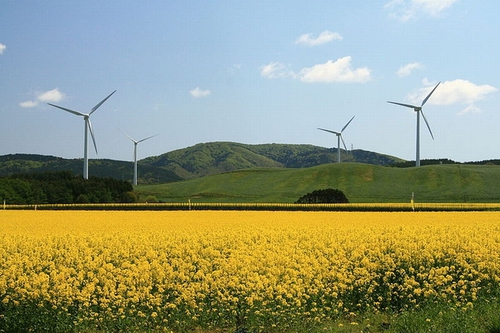December 27, 2013
Aomori Prefecture Leads Japan in Growth of Installed Wind Power Capacity
Keywords: Renewable Energy
 Image by Angaurits. Some Rights Reserved.
Image by Angaurits. Some Rights Reserved.
The New Energy and Industrial Technology Development Organization (NEDO) released on August 15, 2013, the results of its survey on the installation and removal of wind power generating facilities in Japan as of the end of fiscal 2012. NEDO conducts a survey at the end of March every year targeting all wind power facilities 10-kilowatt (kW) or greater that are connected to the grid.
The total installed wind power capacity and the number of wind turbines installed in Japan reached 2,630,000 kW and 1,916 units, respectively, in 2012, ranking the country 13th in the world in installed wind power capacity at 0.9% of the world total. The average capacity per unit is on the rise as well, implying that the size of wind turbines is growing.
Looking at the survey results by prefecture, Aomori stands at the top in installed capacity, at 330,000 kW (13% of Japan's total), with 212 wind turbines (11%). Although Hokkaido heads the list of number of turbines installed, at 280 units, it ranks second in installed capacity, which suggests that Aomori has many wind power installations that have greater generating capacity. Kagoshima, Shizuoka, and Fukushima prefectures follow, both in capacity and in the number of units.
Aomori has been increasing the number of installations in the Shimokita and Tsugaru peninsulas, taking advantage of their wind-rich locations. The prefectural government has formulated a "Strategy Roadmap for Energy Industry Promotion in 2011," with the goal of introducing renewable energy to promote local industries, create jobs, and revitalize local communities. The roadmap estimates that installed wind power capacity will increase by 2020 to 600,000 kW, which is nearly double the current capacity. The prefecture will promote technical training to encourage local companies to enter the maintenance business, as well as enhancement of loan programs through cooperation with local financial institutions.
Related
"JFS Newsletter"
- 'Yumekaze' Wind Turbine Project Connects Metro Consumers and Regional Producers: Seikatsu Club Consumers' Co-operative
- Shaping Japan's Energy toward 2050 Participating in the Round Table for Studying Energy Situations
- Nishiawakura's Initiative for 100% Energy Self-Sufficiency, and a Municipal ICO Scheme
- Actions Toward 100% Renewable Energy in Japan
- Sustainable Community Building in Shimokawa: Recycling-Oriented Forest Management Enabling Permanent Use of Forest Resources
Related
"Popular Articles"
- Current Status of Renewable Energy in Japan (2015)
- Offshore Wind Farm Withstands Great East Japan Earthquake and Tsunami
- Current Status of Renewable Energy in Japan (2014)
- Geothermal Power: Japan Has World's Third Largest Geothermal Reserves, 60 Percent of Which Can Be Developed
- Tokyo Plans to Increase Renewable Energy Ratio to 20% by 2024


